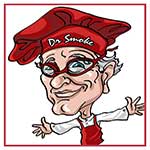Thu 28 May 2020
BBQ SMOKE COLOR
Posted by DrSmokeRead other related stories: Cooking , Cooking With Wood , General Smoking Information , Smoking Tips
[3] Comments

BBQ Smoke color, Black, Brown White or Blue is the key to successful Barbecue flavor
BBQ Smoke Color know the differences Click To Tweet

You smell it before you see it! The aroma of foods being cooked outdoors. When those foods involve cooking over wood – hardwood to be specific – well, it’s a flavor experience that is in a league of its own.
Today, instead of concentrating on the cooking technique of wood-fires, let’s examine the smoke vapor.
Does BBQ smoke color mean anything for flavor outcome?
The quick answer: absolutely! Let’s take a closer look at the finer points of smoke vapor colors.
From Black to Nearly Invisible, The Language of BBQ Smoke Color
There are four basic attributes to smoke when it leaves equipment: volume, velocity, density, and color. It is the combination of these attributes that reveal so much about the color of smoke vapor or gas produced from combusted wood.
Black Smoke = No Oxygen
Black smoke is unattractive, highly dense, consisting of large particles, and the key sign that the wood is starved of oxygen. When air intake is left uncorrected, this black smoke vapor can turn foods acrid, bitter, and sooty. Certainly, this is not the goal of wood-fired cooking! Don’t cook with smoke that is black in color. Learn how to control air intake and exhaust for proper air flow and the best smoke vapor infusion for great flavor.
Gray/Brown Smoke = Poor Wood Quality
You understand air flow, the balance needed between the air intake and outtake. Despite your optimal setting of air flow, you still find gray to brown smoke color occurring. What happened?
Often, this boils down to a case of poor wood choice. Gray or brown smoke occurs when there is a mixture of moisture and hydrocarbons. Bark on woods can stimulate brown smoke as this is the driest and most impure part of the wood. You can also see gray to brown smoke color when there are other stimulants on the wood. It may be that something dripped on the wood, was deliberately applied to the wood, or as part of the wood’s manufacturing process if the wood is a by-product from another process.
White Smoke = Initiation of Heat
Virtually all solid materials exposed to combustion emit white smoke. This means heat is being stimulated to the wood and drying it out. Remember, moisture is water and when heat finds water it has to induct it to produce steam. This takes energy from the fire or ignition and can stall full stages of combustion. Once moisture is evaporated you will observe white smoke to transition to a clearer color, hopefully, the infamous blue. For longer, lower temperature cooking, wait for the white smoke stage to pass before adding the food to the grates. For hotter temperature cooking like burgers, steaks, etc., go ahead and add to the grates even with the white smoke present. The abundance of aromatics at the white stage will allow for the flavor to permeate shorter cook items.
Blue Smoke (or nearly invisible) = Holy Grail of BBQ Smoke Color
Keeping in mind that you don’t always need an invisible or blue smoke to have a flavorful wood-fired cooking event, this is still the goal when cooking with wood for many hours. Blue or invisible smoke means that full combustion has occurred to the wood and the lignin compound is releasing the smoky aromatic that will stick to moist food surfaces. Take advantage of this pristine stage and get cooking for the best wood-fired flavors.
Finding the Perfect Wood with the Perfect Moisture Level for the Ideal BBQ Smoke Color
As a final note, don’t be fooled into thinking that using dry wood will save time on waiting for the fire’s heat to evaporate excess water and get to the flavoring. There is extensive research demonstrating that the ideal smoke composition containing flavor stimulating compounds called carbonyls and phenols is in hardwoods that have a higher moisture rating not the 10% or less that is considered seasoned wood. Use caution when making the wood purchase. Knowing key details about the wood prior to purchasing will help to achieve the smoke color that produces maximum flavor.
Was this posting helpful? Leave a comment or suggestion. We’d love to hear what you’d like to learn more about in wood-fired cooking methods and techniques. Don’t forget, follow us and subscribe so you don’t miss out on anything.

More related reading on Cooking wood, besides knowing your BBQ smoke color importance!
For related reading:
SMOKER AIR FLOW IS YOUR SMOKERS TEMPERATURE CONTROL
Understanding how to use the Water Pan in Smoking
THE BIGGEST MISTAKES TO AVOID WHEN COOKING AND GRILLING WITH WOOD
Products used in this Blog Cooking over Wood:
Wood Chunks- Double Filet
Wood Chips- Grande Sapore®

Dr Smoke- knowing the meaning of BBQ smoke color will keep your results tasty and yummy to you and your guest!
May 23rd, 2018 at 6:56 pm
[…] can be a challenge as wood is a plant material that can be highly variable when put through the stages of combustion. If a mixture of woods is used in the process, combustion rate, biochar production, volatile burn […]
November 27th, 2018 at 6:20 pm
I was sold some wood & told it was pecan but it’s 3 different colors & when I smoked my Thanksgiving turkey with it, my turkey tasted funny & had a rubbery texture! How do I tell if I have pecan wood?
November 28th, 2018 at 11:52 am
Hi Cheryl! Thanks for the question. Pecan varieties usually have a two-tone coloring, not three. One will look yellowish-blone and the other a medium brown. Keep in mind, Pecan is from the same plant genus as Hickory but again, those varieties usually have two colors.
If you really want to know what you have, you can approach your local forestry department who could conduct a sampling on the wood.